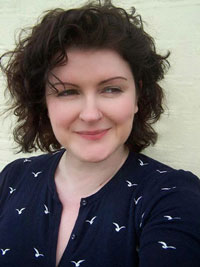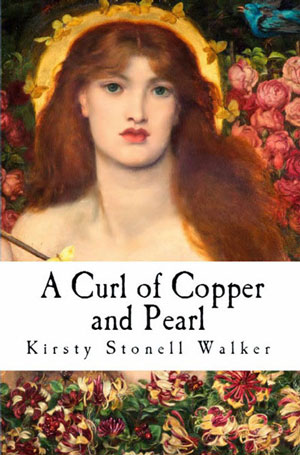1) May I just begin by asking you how one pronounces your name. Is Stonell pronounced like ‘stone all? Or is it more like ‘stow nell?’
Who knew that 7 letters would prove so difficult? I have heard so many different pronunciations of my surname over the years, some of them far fancier than what it actually is. It’s pronounced like ‘tunnel’ but with an ‘o’ instead of a ‘u’, if that makes sense. I was looking forward to changing it to something far more straightforward when I married Mr Walker but of course I had already published so I went the pretentious route of double-barrelling. I’m stuck with it now.
2) Why did you choose the title ‘A Curl of Copper and Pearl?’
To begin with it was called ‘How She Fills His Dreams’, as in the Christina Rossetti poem, but I wanted something that just evoked the vision of Alexa through Rossetti’s eyes. That blend of red and creams just seem to conjure her – the red of her hair, the red of her lips and the cream of her skin. Plus I felt it used the image of the Rossetti hairpin in the hair of a stunner, usually copper in colour.
3) You have written extensively in your biography ‘Stunner’ about another of Rossetti’s models, Fanny Cornforth, and yet you have chosen Alexa Wilding as the focus of your novel? Why was that? What makes her a better choice for a work of fiction?
I did begin with an idea that I would write about Fanny but found I couldn’t for a couple of reasons. Firstly I know her too well – having written Stunner I felt I had told her story and there were no secrets to be seen. Also, people had already done that in other novelisations and whilst I might not have agreed with them, that wasn’t really what I wanted from the novel. What I wanted to do was to tell the story of a period of time but from the viewpoint of an outsider, and so I chose Alexa.
You could argue that Curl is about Fanny because I tell her story from 1865-82 as well as Alexa’s. I get very defensive about Fanny because she is so roundly attacked or dismissed. After all, what did she do that was so wrong? And what did she do that we have proof for? We should always be wary of taking the opinion of someone with an axe to grind and most of what we ‘know’ about Fanny from her contemporaries comes to us with a hearty side dish of prejudice.
Alexa comes without such baggage, so she can see these famous people for what they were: just people, for better or worse. I think you get to see the less delightful sides of Fanny’s character as well as the bits that are lovely, and this is Fanny past her best, when she is pretty much resented and loathed by people. Poor old Fanny!
4) The early chapters dealing with Alex’s humble background are very convincing and realistic in their setting and mood and the way you describe her work as a seamstress. How much is actually known about Alexa’s early life and how much did you need to invent?
I had a census return from 1861 to work from and that was about it. A bit like Fanny, people invented a back story about Alexa which was filled with guesses and assumptions, some of which might have been true but heaven knows which bits. What we know is that in 1861 she lived in a house with her grandmother and her sons, Robert and Charles. Robert was the head of the household, Charles was his brother and Alexa (or Alice as she still was then) was his niece, but her relationship to Charles is not explained. They lived in Warwick Lane just behind St Paul’s Cathedral and by Newgate Prison. The family made their money from the market where the Wilding men were butchers. We have no accurate place or date of birth for Alice, nor any notion of who or where her parents were. Unlike Fanny, no-one bothered to ask Alexa, or at least she did not live long enough, as she died only 2 years after Rossetti at the age of 37.
I wanted to give her a back-story that wasn’t particularly glorious or eventful as I think the facts of life for most people were that if they did not have much money or opportunities then not a lot would happen to them and then they died. In comparison, Alexa had the chance to fly from that into something completely foreign, new, exciting and strange.
5) In the story we see everything through the eyes of Alexa herself, a young woman in an unfamiliar world, with no background in the arts at all. We share in her doubts and perhaps her confusion, also, as to what is taking place in the already established Pre-Rahpaelite circle. Do you feel she was ever fully integrated into that world, reaching a better understanding of what Rossetti and his colleagues were trying to achieve? What I probably mean to say is, how sophisticated, if at all, do you feel she eventually became?
Honestly, I don’t know. Like Jane Morris, she kept her mouth shut so people never said she was ignorant, although we do have that comment by Rossetti saying she was ‘dull’. I find the photographs of her as a young woman to be quite ‘knowing’, as if she understood what part she played in the artist’s fantasies, but it’s hard to see how far she travelled in terms of learning or understanding because she is forever silent. I suppose she gained some sort of integration solely due to her silence – she managed to be present at so many places and times when Rossetti was living his life of artistic excess. She saw so much that it is hard to imagine that she was not affected somehow.


